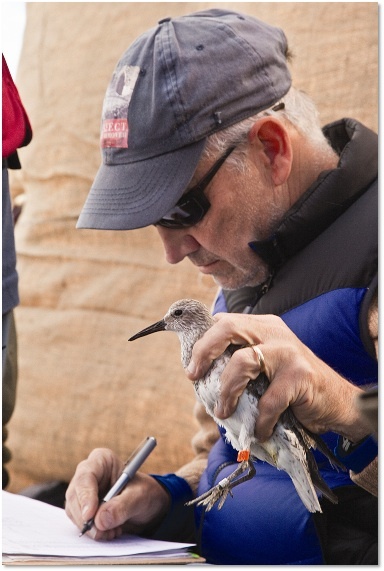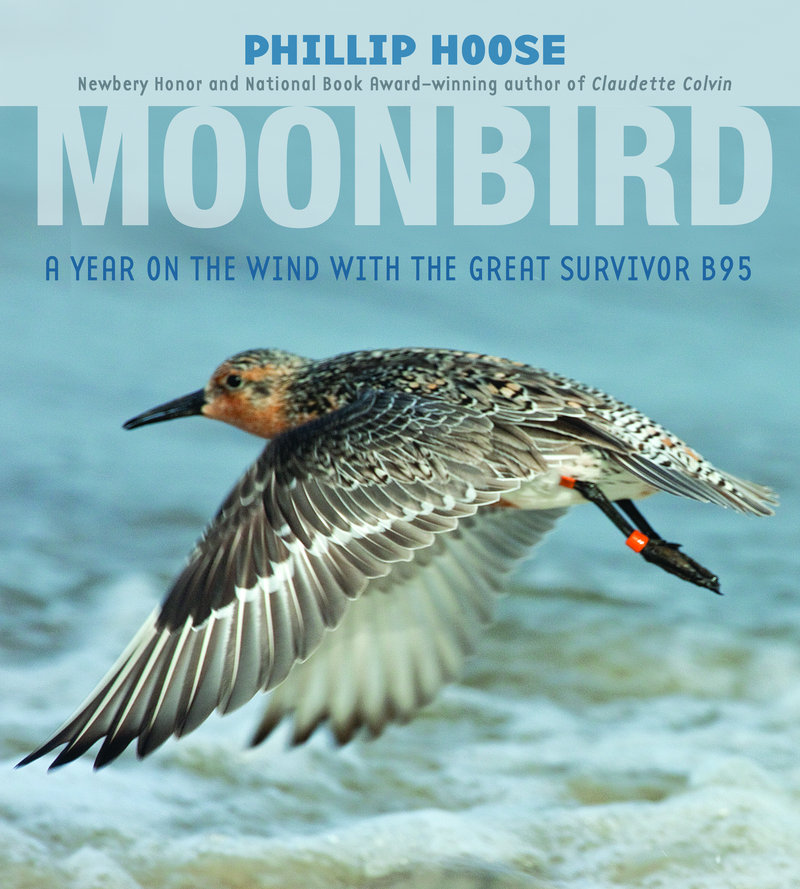National Book Award winner Phillip Hoose has written his 10th book, this one about a small migratory shorebird that he says “has to be among the toughest four ounces of life in the world.”
B95, a rufa red knot whose name comes from the number on his leg band, has somehow survived two decades of annual migration from an archipelago off the southern tip of South America to his Arctic breeding grounds in Canada and back. His incredible resiliency has confounded researchers and offered a glimmer of hope for the survival of his kind.
The entire subspecies of rufa red knots is in trouble. Within B95’s short lifetime, their worldwide population has crashed almost 80 percent. Part of the problem is believed to be the overharvesting of horseshoe crabs in Delaware Bay, a crucial stopover for the birds, where they gorge on crab eggs before continuing their journey north.
Hoose’s new book, “Moonbird: A Year on the Wind with the Great Survivor B95” (Farrar Straus Giroux, $21.99), chronicles the rufa red knot’s struggle to survive and science’s fight to save them. It will be available on July 17.
Hoose, 65, has also written about the plight of the Ivory-Billed Woodpecker in “The Race to Save the Lord God Bird.” He lives in Portland and has worked for The Nature Conservancy since 1977, focusing for the last 20 years on the Great Bear rainforest on the coast of British Columbia.
Q: You’ve said that Charles Duncan (a shorebird scientist at the Manomet Center for Conservations Sciences) gave you the idea for this book. How much did you know about red knots before you started this project?
A: I knew a fair amount about shorebirds before I took it on. I was looking to write another book about extinction, because I felt in a way that the book about the ivory bill, “The Race to Save the Lord God Bird,” had almost been hijacked. The nice discussion that I wanted to have about extinction and how tragic it is and how preventable it is and how worth everybody’s attention it is, kind of got hijacked by the supposed rediscovery of the ivory bill down in Arkansas a few years ago.
So I wanted to write about another creature. I wanted to write about extinction, but focus on a creature that was in trouble but not in the pit. I was looking around, and Charles is a good friend of mine. He kept saying, “Why don’t you write about the red knot? It’s got everything. It’s the ultimate long-haul trucker. It migrates from the bottom of the Earth to the top. It’s beautiful, especially in its breeding plumage. It’s tanking. The numbers are going down year by year by year. What about it?”
But I kept holding off. I kept saying to him, and everybody else, “I want to focus on a single character.” All these years of writing has taught me that readers seem to need a protagonist, and they need a protagonist who is stressed, who has real problems. Somebody they can identify with, you know?
Charles called me up one day and said, “I found your bird.” He had conversed with Patricia Gonzalez, a biologist from Argentina who told him about a bird that had been trapped as an adult, meaning it was in its second or third year, maybe more. This happened in 1995, and they kept seeing it over the years, and I think when Charles called me — this was probably 2009 — they had seen it again. It was becoming famous. It was becoming this rock star bird. No one could believe how long it had lived. By then, I guess it would have been maybe 18. By now, it’s probably 20.
Q: And what is the usual life span for this bird?
A: Slightly more than half of them do not survive the arduous first year, the whole circuit that they make from the bottom of the world to the top and back. About 45 percent make it, and about 55 percent don’t. But it’s like a lot of migrating birds. If you can make the first circuit, you can live on to be 5 or 6, because you learn things every time around. You get better at the navigational aspect of it. You just get more experience. You learn things. So maybe 5 or 6.
But this bird was off the chart. They started, in Argentina, to tally up the distance it had flown, and it’s about an 18,600-mile annual round trip. And they multiplied that by its supposed age at the time, and they started calling it Moonbird because they realized its lifetime frequent flier mileage had exceeded the distance between the Earth and the moon and actually halfway back. So Charles told me this, and I just said, bingo, that’s the bird.
Q: Your description of what happens in the bird’s body while it’s preparing to migrate, and then the description of the migration itself, was fascinating. Did you pull all that together from interviews with shorebird biologists?
A: I would say most of it came from interviews, but there’s also a fair amount of literature out there about this. It’s just amazing. They seem to be able to convert their bodies to be able to do anything they need to do. I mean, imagine being able to grow a bigger brain before a big test or whatever, and that’s just the way they seem to be able to do it. They can inflate themselves with food. They eat mussel spat down in Tierra del Fuego in the winter, and they just pork up, and it’s as if they’re inflating a balloon. I have a picture in the book you’ve probably seen.
Q: Yes, I have to say that picture (of a corpulent red knot) made me laugh out loud.
A: Well exactly. And some of these birds, they’re like big cargo jets. They need a real long runway. They run and they run, and probably don’t make it and they have to try (taking off) two or three times, they get so big. But they eat all this protein and they convert it to fat, because fat turns out to be the optimum jet fuel. And at the same time as they’re enlarging their hearts, parking and compartmentalizing all this fat and stuff, they’re also ditching weight that they don’t need. Their leg muscles wither. Their gizzard, which is used to grind food, shrinks way down to save weight. By the time they are ready to go, they are just flight machines. They are absolutely power-packed with fuel and not carrying a gram more than they have to carry.
Q: Do scientists have any theories as to how B95 has survived so long? Is it just luck, or is there something about him that’s different biologically?
A: I asked the scientists I interviewed that question, and some of them said it’s just superior genes, in the way that some people live to be 100. Some said luck. But there were other theories that were really interesting. One said (B95) may have a genius for the center of the flock. For example, when the falcon wants to attack a flock, it wants to carry one individual out of the flock so it can concentrate on one bird and nail it. But if you stay in the middle, that isn’t going to be you.
Q: B95 was seen again in May. Were you excited?
A: Oh, are you kidding? Yes, I was very excited. He was seen on May 28 by Patricia Gonzalez, the very biologist who put the band that says “B95” on his upper left leg. She was in Delaware Bay working with a group of scientists, and one morning they were going to go out banding, I think, or spotting birds, and the rest of the party that she was with was late. She got ready before the others, and so she went out on her deck and there was a spotting scope out there. She looked through it, and there he was. She was just beside herself.
And she took a photograph to prove it, so that’s pretty cool. So you not only have proof, you have a glimpse of how far along he was in his preparation to fly to the Arctic, which was his next stop. And he looked pretty good. He looked pretty chunky. Biologists say that these birds need to weigh 180 grams in order to have enough fuel to make it to the Arctic and also to survive for up to a week, because sometimes they arrive and their food source is covered with snow and the ponds are still frozen.
Q: Did you ever personally get to see him?
A: No, I’m one of the many who has chased him all over the place and never seen him. I always just miss him.
Q: What do you think we can learn from this little bird?
A: I identify deeply with B95. He prepares well. He’s very persistent. It’s hard to imagine what he’s gone through. Imagine the southbound journey from the Mingan, which is sort of the mouth of the St. Lawrence, all the way to northern South America — thousands of miles in September over the Atlantic Ocean, when there are hurricanes and tropical storms and when the air is turbulent. You know, these are genes you’d want to pass on. And year after year after year, he passes them on.
We’ve always seen him at three places: Delaware Bay, Mingen and Tierra del Fuego. And every time that we don’t see him there at one of these three places, there’s a mounting sense of sadness and fear that well, you know, nobody lives forever. Maybe this is it. Maybe his time has finally come. And then the little guy just beats us all. He shows up. You asked how I felt when I heard about (the May sighting of B95), and it’s just elation. Wow, what a stud (laughs).
Staff Writer Meredith Goad can be contacted at 791-6332 or at:
mgoad@pressherald.com
Send questions/comments to the editors.





Success. Please wait for the page to reload. If the page does not reload within 5 seconds, please refresh the page.
Enter your email and password to access comments.
Hi, to comment on stories you must . This profile is in addition to your subscription and website login.
Already have a commenting profile? .
Invalid username/password.
Please check your email to confirm and complete your registration.
Only subscribers are eligible to post comments. Please subscribe or login first for digital access. Here’s why.
Use the form below to reset your password. When you've submitted your account email, we will send an email with a reset code.